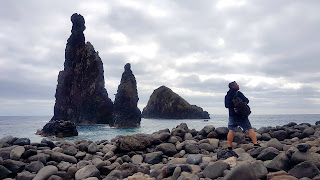Everything But The Girl - Corcovado - YouTubeI'd planned a visit to Madeira, to fall before the tubenose altar, prior to the global pandemic but it's taken a few years to get back to doing something about it. In the meantime the many hours of UK seawatches and pelagics have been exhilarating and delivered far beyond my hopes with Fea's and Wilson's Petrels in the South West and an Albatross and White-billed Diver in the North Sea amongst all the shearwaters, terns, incoming passerines and the odd Sabine's Gull.
Our seabirding on Maderia fell into 3 types - Seawatches, pelagics and nocturnal breeding site visits. We went out on 3 long pelagic trips with Windbirds which allowed for fantastic views of seabirds both in transit to our chumming points and when working the oily slicks. Seawatching gave us fantastic and repeated experience with seeing petrels and shearwaters in a different context - we seawatched daily from just after dawn and we only encountered Barolo's Shearwater through this approach, trawling through large feeding flocks of shearwaters drawn to pods of Dolphin's. A highlight, amongst many highlights, of the trip was being guided to the Zino's Petrel breeding cliffs high in the mountains. The experience was magical but taking the plunge to buy a thermal imaging camera for this made for something exceptional. Using the camera we could not only hear the haunting wails of the petrels, we could look down the sheer cliff face and see Zino's Petrels emerging from the cloud below us and hang and dance upon the ferocious updraft of the cliff. We used our ears and the camera at Ponta do Garajau to enjoy Cory's Shearwaters flying around their small colony, the air filled with crazy loon calls. Braving the rocky outcrop at the end of the path we were overjoyed to hear the finger rubbing on glass squeeks of Madieran Storm Petrel hopefully returning to breeding spots. A video will follow in time but here are some pics to whet the appetite.
The Stage
Madeira is rugged and dramatic in it's scenery, we bumped into some great vista's and coastline and sunsets during our birding.
The Stars
Desertas Petrel
This chunky bird with a beast of a bill is very likely to be a Deserta's Petrel. Every Pterodroma experience is an adrenaline laced tingle fest. We had many visits from birds on the boat and seawatching produced many birds from land - reliving that UK find over and over again was delicious.
Fea's/Deserta's Petrel
Zino's Petrel
We saw 3 (possibly 4) birds at sea, and a bird from a seawatch that we were as sure as we could be was a Zino's and several birds at the breeding cliffs. I hadn't even got my camera out of the bag for the exceptionally close views of our first which took off from a small flock of Bulwer's Petrel at the bough of the boat as we headed out on our first pelagic, the photographs of our next zipping around the boat, in evening light still show the lighter structure, bill size and white underwing markings of this enigma. Word's can't convey the experience of watching this bird whip headlong towards us, banking feet from the boat and returning over our heads their mountainous breeding sites etching the horizon below.
Supporting Cast
White-faced Storm Petrel
We hadn't any realistic hope that we'd bump into one of these - hugely enjoyable bird to watch and it returned a couple of times as it bounced along the slick. A cracker.
Maderian Storm-Petrel
I won't wade into the taxonomy of Band-rumped Storm Petrels. We saw a couple of these at sea and enjoyed them immensely.
Bulwers Petrel
Abundant at sea but fantastic value throughout
Great Shearwater
Just the one, it got a bit sidelined as both a Zino's and Fea's type joined the slick almost as soon as it appeared.
Abundant and fantastic birds. Close views and huge flocks were spectacular.
Land Birds
Madeira has a limited but interesting avifauna with island races verging on the edge of bona-fide endemics. Trocaz Pigeon took a while to show itself really well and the Maderian Firecrest frequently heard but harder to see, although some birds performed including a bird feeding young. Plain Swift, Berthelots Pipit and Canary were new to me as was the Maderian race of Chaffinch and the endemic island Lizard.

































_edited.jpg)
_edited.jpg)
_edited.jpg)
_edited.jpg)
_edited.jpg)
.jpg)
_edited.jpg)
_edited.jpg)
_edited.jpg)
_edited.jpg)
_edited.jpg)
_edited.jpg)
_edited.jpg)
_edited.jpg)
_edited.jpg)
_edited.jpg)
_edited.jpg)
_edited.jpg)
_edited.jpg)

_edited.jpg)
_edited.jpg)
_edited.jpg)



.jpg)




.jpg)
.jpg)
.jpg)
.jpg)
.jpg)
.jpg)
.jpg)